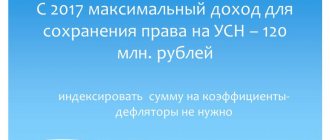Criteria for applying the simplified tax system
According to the legislative act, payers of the simplified tax system are legal entities that have transferred and are applying the special regime in the manner established by Chapter. 26.2 Tax Code of the Russian Federation.
Entrepreneurs and companies voluntarily switch to using a special regime:
| The tax base | Bid, % |
| Income | 6 |
| Income minus Expenses | 15 |
Regional regulations may adopt differentiated tax rates according to the simplified tax system in the first case 0-6% , in the second 5-15% . The reduced tariff applies either to all legal entities or to certain categories.
Not everyone can voluntarily switch to a special regime; there are clear restrictions on the transition and use of this special regime. These norms are regulated by Articles 346.12 and 346.13 of the Tax Code of the Russian Federation.
New reporting
The latest news in changes to the 2021 tax system is the introduction of a mandatory electronic reporting form. This innovation will not affect everyone, but only companies and entrepreneurs whose staff (average staff size) will be more than 25 people. Smaller entrepreneurs will still have the opportunity to independently choose in which form - paper or electronic - to submit reports. The process of electronic submission of reports will occur through a special program that will send the entered data to Rosstat via secure communication protocols.
In addition, the Federal Tax Service presented a new form of form 6-NDFL (quarterly report) and introduced a rule according to which employees will be able to obtain documents necessary to receive tax deductions related to treatment and payment for educational services directly from their employer.
Income limit for switching to simplified tax system
One of the main requirements for the transition and application of the simplified tax system for legal entities is the limitation on the maximum amount of income . An organization has the right to switch to a simplified regime only if, based on the results of its activities for nine months of the year in which it notifies the fiscal authorities of the transition to the special regime, revenue does not exceed 112.5 million rubles .
Every year until December 31 of the current year, the revenue limit is subject to indexation. For this purpose, the deflator coefficient established for the next year is determined. Let us recall that for three years 2017–2019 the revenue limit was not indexed by the deflator coefficient in accordance with Federal Law No. 243-FZ of July 3, 2021.
Thus, the maximum income of an enterprise for the transition to the simplified tax system from 2020 cannot exceed 112.5 million rubles.
Social payments
Another change to the USN for individual entrepreneurs in 2021 is an increase in the amount of mandatory social payments. Due to the fact that the Government decided to index the minimum wage in 2021 to 6,024 rubles. Contributions to the PFR and FFOMS funds will also increase and amount to:
- Pension Fund payments – 20,826 rubles;
- FFOMS – 4085 rub.
Let us remind you that individual entrepreneurs, regardless of whether they are carrying out business activities in the current period or not, are still required to pay fixed social payments. They are calculated using the following formula:
Fixed contribution = minimum wage * tariff rate * 12 calendar months.
The tariff rate is:
- For the Pension Fund - 26%;
- For FFOMS - 5.1%
The procedure for switching to the simplified tax system
To switch to a simplified taxation system, enterprises must be guided by Articles 346.12 and 248 of the Tax Code of the Russian Federation.
The Tax Code clearly regulates the procedure for determining an enterprise's revenue for nine months of the current year for the transition to a special regime. Consequently, in order to switch to simplified taxation, merchants take into account the following types of income:
| Types of income | Article |
| From the sale of goods, works, services | Article 249 of the Tax Code of the Russian Federation |
| From the implementation of property rights | |
| Non-operating | Article 250 of the Tax Code of the Russian Federation |
When determining the maximum amount of revenue, it is necessary to exclude taxes that are imposed on the purchaser of works, property rights, services and goods. These rules for accounting for income for the purpose of switching to the simplified tax system are general.
Transition to the simplified tax system when combining several tax regimes
If a company that combines several taxation systems, for example, OSNO and UTII, intends to switch to a special regime, then for certain types of activities the maximum amount of revenue that determines the possibility of switching to a special regime must exclude income received under UTII and determine only revenue from activities related to BASIC.
Transition to the simplified tax system when applying UTII
Note that the Tax Code of the Russian Federation does not regulate the procedure for determining the maximum amount of income for the transition to simplified taxation for enterprises operating exclusively in the UTII regime. It follows that in such cases there is no need to calculate the revenue limit . This conclusion can be made on the basis of Article 346.12 of the Tax Code of the Russian Federation and the explanations of the Ministry of Finance of Russia contained in Letter No. 03-11-11/255 dated October 5, 2010.
Nature of activity
Some organizations and entrepreneurs are expressly prohibited from using simplified rules. For example, when their activities are related to insurance, microfinance or the production of excisable goods.
Situation: is it possible to apply a simplification if an organization (autonomous institution) has separate divisions?
Yes, you can. But only if the separate divisions are not branches. The presence of representative offices from 2021 does not prevent the application of the simplification.
The Tax Code directly prohibits the use of simplification by organizations (autonomous institutions) that have branches. At the same time, there is no prohibition in general for everyone who has separate divisions (subclause 1, clause 3, article 346.12 of the Tax Code of the Russian Federation).
The concept of “separate division” includes the concept of “branch”. But the composition of separate divisions is not limited to branches. An organization may have other separate divisions: representative offices, additional offices, warehouses, etc.
How to distinguish a branch from other separate divisions? Firstly, information about branches must be entered into the Unified State Register of Legal Entities. Other separate divisions are not entered into the register. However, please note that you need to notify the tax office and funds when creating any division.
Secondly, it is important how formally this or that division is named in the documents. If there is no record that a branch has been created, then the division cannot be recognized as such.
Thirdly, it is clearly defined for departments what functionality they can perform. Thus, a branch is opened when they want to provide the division with all the functions of the parent organization or an autonomous institution. The remaining divisions are assigned other more “narrow” functionality.
All this follows from Article 11, paragraph 1, 4 of Article 83 and paragraph 2 of Article 346.12 of the Tax Code of the Russian Federation, Article 55 of the Civil Code of the Russian Federation.
A similar point of view is expressed in letters of the Ministry of Finance of Russia dated June 29, 2009 No. 03-11-06/3/173, dated January 23, 2006 No. 03-01-10/1-14. Currently, these letters can be relied upon to the extent that they do not contradict subparagraph 1 of paragraph 3 of Article 346.12 of the Tax Code of the Russian Federation.
Notification to fiscal authorities about the transition to a special regime
The income limit is not the only requirement that organizations must meet when switching to a simplified taxation regime.
If companies and entrepreneurs meet all the requirements for switching to the simplified tax system from the next calendar year, they are required to notify the tax office no later than December 31 of the current year. In this case, the notification must be sent to:
- organizations - to the fiscal authorities at the place of registration of the company
- for entrepreneurs - to the tax office at the place of residence
In other words: after making a decision to switch to a special regime, you must send a notification to the tax office by December 31 of the current year about choosing a simplified taxation system and apply the simplified tax system starting next year.
The recommended form of notification (form N 26.2-1) was approved by Order of the Federal Tax Service of Russia dated November 2, 2012 N ММВ-7-3/ [email protected] In addition to the paper form, notification to tax authorities can also be submitted electronically. The format for submitting the notification in electronic form was approved by Order of the Federal Tax Service of Russia dated November 16, 2012 N ММВ-7-6/ [email protected]
The notification must provide reliable information:
- object of taxation
- residual value of fixed assets as of October 1 of the current year
- the amount of income determined as of October 1 of the current year
Please note that a company that has not notified the fiscal authorities within the required time frame does not have the right to apply the special regime.
Attention! For companies that used the UTII regime and decided to switch to the simplified tax system, the procedure for submitting tax notifications is somewhat different. They must notify the fiscal authorities no later than 30 calendar days from the date of termination of the obligation to pay UTII.
Checks
Starting in 2021, a provision abolishing unscheduled inspections of small businesses will come into force. To be more precise, we are talking about a moratorium for a period of 3 years. By and large, this can be considered the only good news without objection in the field of changes for individual entrepreneurs in 2021.
This moratorium does not apply to unscheduled inspections by tax and other regulatory authorities. This means that if facts arise that make it possible to suspect an entrepreneur of a violation, government agencies will have every reason to come to him with inspections. Moreover, the grounds for such suspicions in practice can be very different; most often, “complaints” of dissatisfied and vigilant citizens will be used.
Limitations on the use of the simplified tax system
The Tax Code has another limitation on the maximum amount of revenue, which applies to all payers of the simplified tax system. We are talking about exceeding the income limit , which entails the loss of the right to use the special regime. If, based on the results of the tax or reporting period, the income of a legal entity exceeded the threshold of 150 million rubles , the merchant loses the right to apply the simplified tax system. Moreover, he needs to switch to a different taxation regime from the beginning of the quarter in which the excess was allowed.
In Art. 346.19 of the Tax Code of the Russian Federation clearly defines the concepts for applying the simplified tax system:
- tax period is a calendar year
- reporting period is 1st, 2nd and 3rd quarters
The income limit of 150 million rubles, which affects the use of the special regime, has not changed for three years. Accordingly, in order not to go beyond the limits provided for by legislative acts, merchants using the simplified tax system must regularly monitor their income not only at the end of the calendar year, but also every reporting period.
How to stay on the simplified market in 2021
From 2021, organizations and individual entrepreneurs have the right to apply the simplified tax system if:
- income did not exceed 200 million rubles;
- the average number of employees did not exceed 130 people;
- the residual value of fixed assets is no more than 150 million rubles.
Note that the last condition for continuing to work on the simplified tax system in 2021 has not changed, unlike the first two.
Previously on the topic:
What can be ignored in income under the simplified tax system?
Transition from UTII to simplified tax system: how to take into account income?
What income is included in the limit?
Legal entities must remember that the limit of 150 million rubles includes the following income:
- from sales
- non-operating
- income that the organization received when switching to a special regime with OSNO, provided that they were not taken into account as part of the revenue for OSNO. This norm is enshrined in paragraph 4 of Art. 346.13
The Russian Ministry of Finance clarified that when monitoring revenue, one should take into account the income of a legal entity received during the tax period and, accordingly, during the reporting period (Letter of the Ministry of Finance of the Russian Federation No. 03-11-06/2/24984 dated July 1, 2013).
When calculating the maximum amount of revenue that affects the application of the simplified tax system, expenses do not need to be taken into account, even if the simplified tax is paid on the difference between income and expenses:
- if an organization applies both the simplified tax system and the special tax system, then when calculating the income limit, revenue under two special modes should be taken into account
- if an organization applies both the simplified tax system and UTII, then the revenue received from “imputed” activities does not need to be taken into account
What is turnover
Turnover (revenue) is all amounts of money earned by an entrepreneur during the reporting period. The importance of the indicator in simplified taxation is due to several factors.
- Prohibition of the use of simplifications when limits are exceeded;
- at high incomes, using the mode is inappropriate.
If the revenue limit under the simplified tax system 2021 is exceeded, payments of contributions and fees to the state treasury under the simplified tax system are automatically carried out. This is due to the fact that the simplified mode is intended for micro-sized businesses; if they are larger, other payment schemes are used. Let's consider what the income limit is under the simplified tax system, and how to correctly carry out calculations.
Declaration according to the simplified tax system
What happens if the income limit for the reporting period is exceeded
If, based on the results of activities for the reporting period, the taxpayer exceeds the maximum permissible revenue threshold, he automatically loses the right to apply the special regime . A legal entity is obliged to switch to the OSN from the period in which, according to accounting data, the income received exceeded the maximum permissible limit.
In this case, an individual entrepreneur or organization is obliged to transfer all taxes to the budget in accordance with OSNO. At the same time, administrative punishment in the form of fines or accrued interest for non-payment of monthly taxes during the reporting quarter in which the merchant switched to OSNO will not be applied.
to notify the fiscal authorities within 15 calendar days after the tax (reporting) period If the payer does not notify his inspectorate in a timely manner, he will be subject to administrative punishment in the form of a fine.
Attention ! If the payer, after losing the right to use the simplified tax system, did not switch to another regime or switched in violation of the deadlines, for untimely transfer of monthly payments to the budget after the expiration of the reporting period in which the legal entity was obliged to switch to another taxation regime, penalties will be imposed on it and accrued penalties according to tax legislation.
Limits regarding the cash register
When using a cash register, according to legal regulations, the business owner must set a limit at the end of the working day on its balance.
In this case, the owner is obliged to independently calculate this limit without informing banking structures about the excess.
For example, sum up all revenue for 90 days and divide it by the number of days in the billing period. Next, multiply the amount received by the number of days during which the funds remain in the cash register, usually this is a week; the amount received is the limit.
Important: such a scheme must be drawn up as a regulatory document and used in all divisions of the enterprise that donate funds to the main office.






